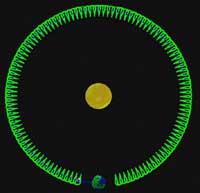Little brother of the Earth
In the orbit of the Sun it moves at a speed higher than that of the Earth, sometimes fleeing from it and others approaching the Earth. As it approaches the Earth in this orbit it moves backwards, forming a horseshoe orbit. At the same time, it revolves around the Earth's orbit.

Astronomers working on a project in which asteroid AA 29 automatically observes the firmament discovered it on January 9, when the horseshoe shape orbit was ending. Therefore, in one of the closest and brightest moments to Earth. Since then the small asteroid has been closely watched. "2002 Asteroid AA 29 must be placed in the same classification as Rock 3753 Cruithne, but it is more important. 3753 Cruithn forms a horseshoe orbit near the Earth's orbit, while 2002 AA 29 moves in the same orbit. That is why we have considered him as the little brother of Earth." The statements are by Martin Connors, astronomer at the Canadian University of Athabaseca.
On January 3, 2003 asteroid 2002 AA 29 will be very close to the Earth, but then it will begin to move back faster than the Earth. These data are the result of studies carried out since last January. And astronomers have also released more curious conclusions. For example, in the year 550 the asteroid became for a few years the natural satellite of the Earth, and the same will happen in the years 2600 and 3880. At this time, however, the gravitational force of the Sun will be technically dominated.
Objects that revolve around planets or planets are not new, Jupiter's Trojans or those found around Mars are witnesses to this. As they have not yet been properly studied, researchers have already begun to develop research plans for asteroid 2002 AA 29, including placement of a probe or sending some group of astronauts. If the intentions were to come true, the younger brother of Earth would be the second object of space that man would step after the Moon. However, it is believed.
Buletina
Bidali zure helbide elektronikoa eta jaso asteroko buletina zure sarrera-ontzian











